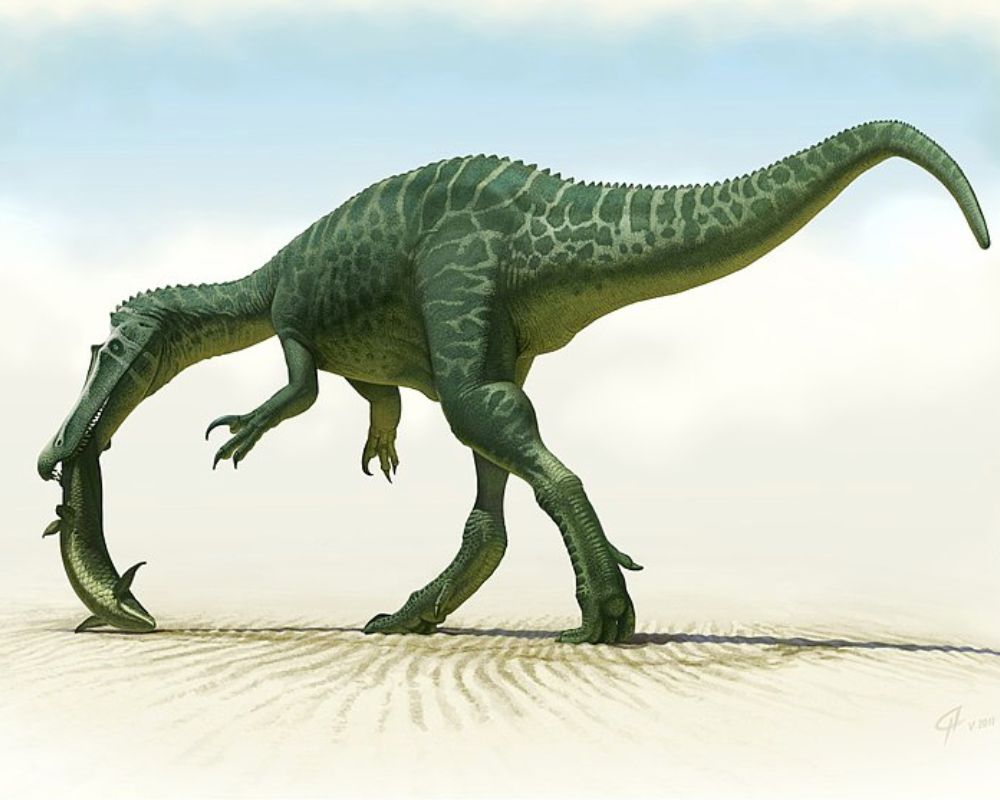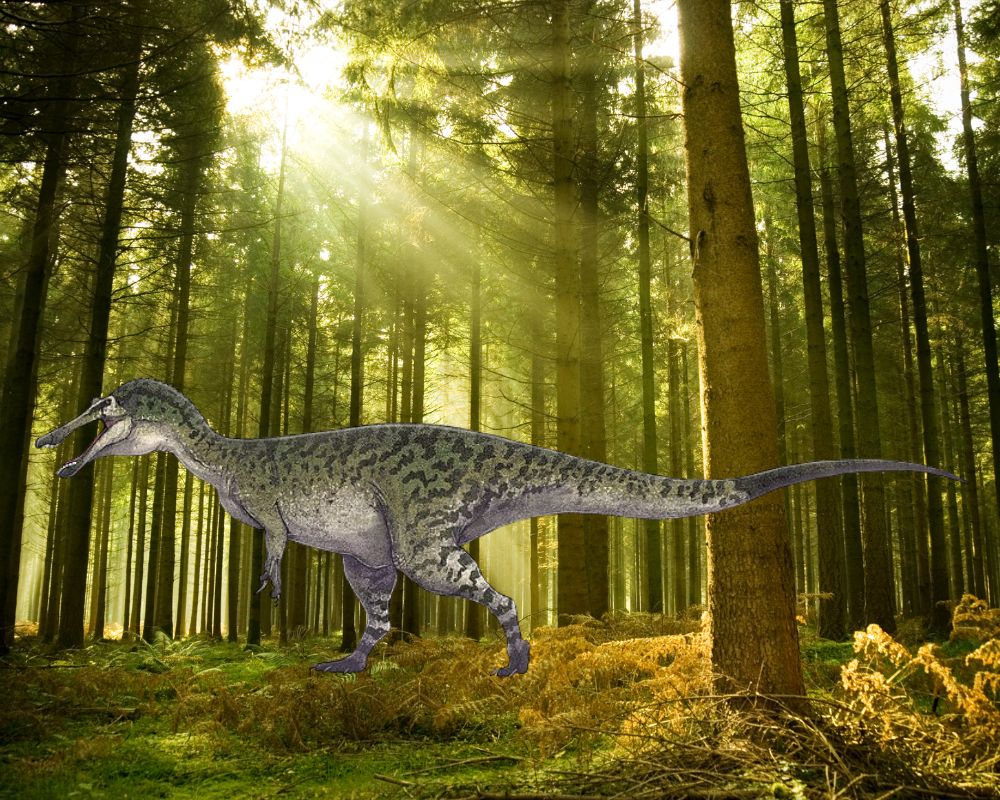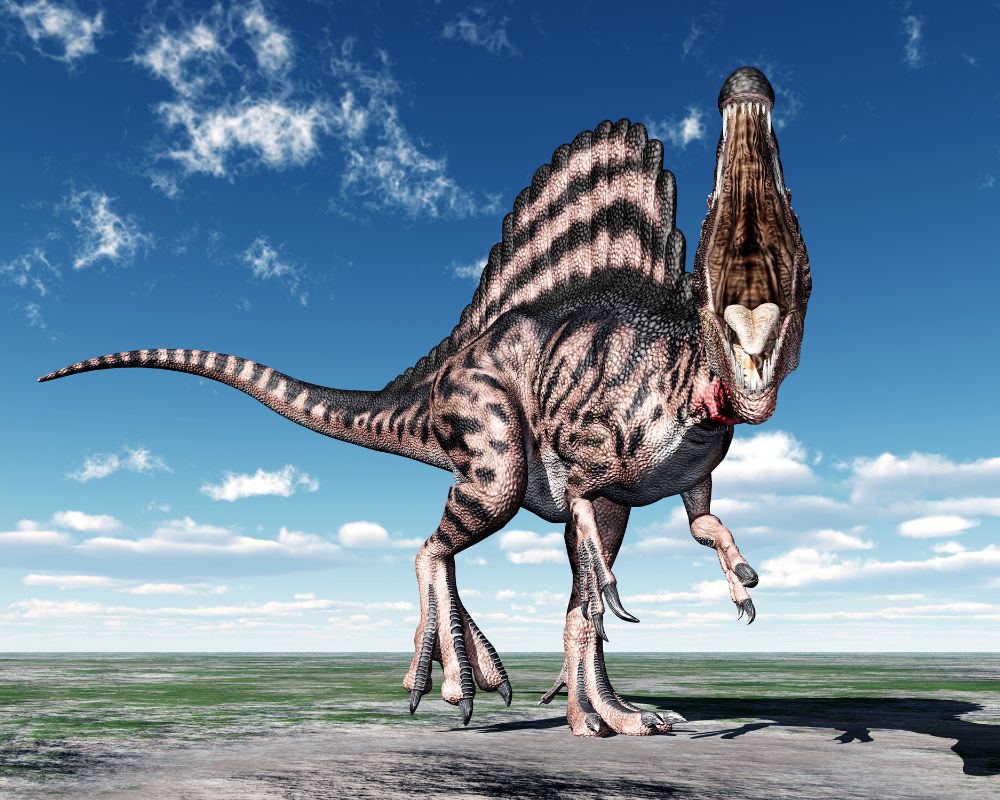A Baryonyx was a large Theropod dinosaur with a large claw on each thumb. Its mouth was narrow with lots of sharp, serrated teeth. The Baryonyx had useful forelimbs that could grasp fish and other meat.
Table of Contents
Some Quick Facts About the Baryonyx

| Name | Baryonyx walkeri (meaning “Heavy Claw”) |
| Type of dinosaur | Spinosauridae dino |
| Territory | Pine forests along large waterways in England, Spain, Portugal |
| Size | Big dino, 25-33 feet long, 8-10 feet tall |
| Color | Unknown, but probably olive green like crocodilians |
| Interesting Characteristics | Could swim in shallow water and had large claws on each thumb |
| Diet | Piscivorous (fish eater), scavenger, and carnivore |
| Major Threats | Climate change, larger carnivorous dinosaurs |
The Baryonyx was a large Theropod about the size of Allosaurus and Carnotaurus. Baryonyx was a great swimmer that ate mostly fish, but like many carnivores, Baryonyx was also a scavenger. It was an interesting dino comfortable on land and in the water.
While Baryonyx wasn’t as scary, look at a T-rex, it could run about 30 mph! The Baryonyx had a large claw on each hand that could slash at any dino trying to steal its food!
What was the Baryonyx like?

It measured around 26 to 33 feet in length. It had a long, slender snout filled with sharp teeth and powerful arms with large claws.
The Baryonyx likely used its claws to catch fish and other small prey in water bodies. It was bipedal and had a distinctive sail-like crest on its back. This dino represents a crucial connection between Theropod dinosaurs and their adaptations to aquatic environments!
What did the Baryonyx Eat?
The Baryonyx ate just about anything but vegetables! Paleontologists found preserved fish scales inside a Baryonyx fossil, proving it was piscivorous. Still, that’s not the only thing found in the Baryonyx’s belly.
Young Iguanodon bones and Pterosaurs were also found inside the Baryonyx. It was also known to scavenge from bodies of other dinos, including Sauropods, Raptors, and anything else it could get its mouth on. Baryonyx was a valuable part of nature’s cleanup crew in the Mesozoic Era!
What was the difference between the Baryonyx and the Spinosaurus?

The Baryonyx was related to the Spinosaurus and other Spinosaurs. Even though the Baryonyx could swim, it had different adaptations than the Spinosaurus. The biggest difference was that the Baryonyx didn’t have a sail fin like the Spinosaurus and the Irritator.
The Baryonyx did have a lot of similarities with other Spinosaurids, especially a Suchomimus and an Iberospinus. The Baryonyx had a narrow snout like a crocodilian with lots of teeth. The Baryonyx also had three fingers on its hand with a single large claw in the first position.
When and Where Did Baryonyx Live?
The Baryonyx lived in Western Europe during the Barremian Stage of the Early Cretaceous period. The areas where Baryonyxes have resurfaced are now England, Portugal, and Spain. Based on fossil evidence, paleontologists believe the Baryonyx lived from 130 to about 125 million years ago.
Western Europe was full of cool dinos in the Early Cretaceous period. These dinos included:
- Eotyrannus
- Hypsilophodon
- Iguanodon
- Neovenator
- Polacanthus
- Pterosaurs
Where was the Baryonyx Discovered?
The Baryonyx came up in Surrey, England’s Smokejack Clay Pit. Fossil collector William Walker found a Baryonyx bone in 1983. Walker brought his find to London’s Natural History Museum that same year.
In 1986 paleontologists Charig and Milner named the new dinosaur Baryonyx walkeri in honor of Walker. Baryonyx fossils have also been found in the Isle of Wight, Spain, and Portugal. So far, only one species of Baryonyx is known to paleontologists.

